Schoolchildren learn very early that the Statue of Liberty was not manufactured at its location in New York Harbor. Instead, it was fabricated in France and shipped piece-by-piece across the Atlantic Ocean to where it currently stands as a beacon to freedom and liberty for all the world to see.
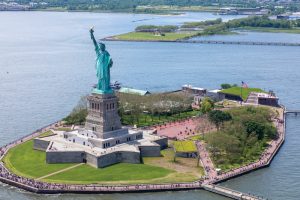
History has repeated itself; the Statue of Liberty Museum’s 83 precast concrete pieces were also manufactured offsite and shipped from 150 miles away in Denver and Pennsylvania. Crews then assembled the pieces at the northern tip of Liberty Island.
The museum exhibits are about freedom, immigration, and the entire story of the statue: why and how it was made and transported, how money was raised to have it built in New York, the gateway to America, the experiences of immigrants entering the harbor and seeing the lady of the harbor, and watching maintenance and renovation activities over the years.
The museum’s concept stemmed from respecting the site, the statue, and its history. “We wanted to defer to the statue and coordinate with existing materials on the island,” said Dan Piselli, a senior associate with FXCollaborative (FXC) Architects, designer of the museum.
The museum provides a new setting for the statue’s torch, offering panoramic views of Lady Liberty and Lower Manhattan. The green roof is planted with native grasses. In addition to the striking precast concrete panel façade, the structure uses the same granite, bronze, and copper used for the statue’s pedestal more than 130 years ago. Stony Creek granite was selected for the project because the material was used on the original pedestal. It was retrieved from the same quarry in Connecticut.
General contractor Phelps Construction was forced to handle many logistical issues on this project, which was in the middle of New York Harbor. Precast was the ideal construction material to resolve these issues. Precast concrete allowed each piece to be individually shipped to the site rather than creating an area on-site to store and stage construction materials. The speed of erection was also much faster than it would have been with concrete poured at the worksite. Once the pieces arrived on site, they were quickly placed and assembled with a crane and a small crew of ironworkers.
Crucial Early Coordination
The nature of prefabrication leaves little room for error in the field, so coordination during the design phase was critical. “We were able to talk in real-time, viewing the models and envisioning what would happen in the field,” says Piselli. The museum’s complex geometry required intricate contours. It is an irregular shape with numerous cuts and angles and not very repetitive; forms could not be used repetitively. Corner panels were very custom and had acute angles. High Concrete Group shared Tekla models showing how the panels would connect to the steel frame.
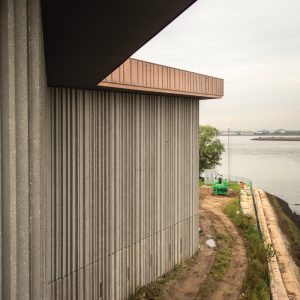
In addition to aesthetics and geometry, the precast concrete panels had to be designed to provide lateral stability for the building structure. This was realized during early coordination between the construction team and the design team, resulting in the elimination of cast-in-place shear walls initially specified. Each panel was engineered to resist lateral shears and moments specified by the Structural Engineer and subsequently anchored to the roof diaphragm. At the exterior, the team designed pockets and corbels to receive the steel beams, eliminating the need for perimeter columns and dispersing the weight of the green roof above to the building perimeter.
Energy efficiency was crucial to the museum’s enclosure. It uses a low window-to-wall ratio, highly insulated walls, extensive thermal bridge mitigation, and internal thermal mass to moderate energy use for heating and cooling. Continuous insulation achieved R-19 by enclosing 4 inches of rigid insulation in the precast concrete panels.
Using precast concrete sandwich panels allowed the project team to thermally isolate the building more than with a single wythe and eliminated the need to insulate on site. The building benefited from the thermal mass and eliminated thermal bridges.
Design Considerations
The new building was set 10 feet above the adjacent plaza, which is 5 feet above the base flood level. Resiliency requirements included surviving a 100-year flood or storm. This was especially important since Superstorm Sandy struck this region in 2012. FXC’s design focused on selecting resilient materials in conjunction with durable and appropriate construction methods to withstand major disasters and climate change. Drainage slots were incorporated into the base to ensure future resiliency and reduce the large hydrostatic loads that would have resulted from a fully enclosed condition. Flood holes varied from 2 feet high to 5 feet, 8 inches high by 4 inches wide.
Storm surge water should come into the flood zone and flow back out. The area below the first floor is an open, unusable space, enclosed by precast walls with openings cast into them. The panels on the lower level in the flood zone are 21 inches thick to resist the force of waves breaking against the building while supporting the structure above.
The panels at the flood zone, which is 19 feet above sea level, are “horizontal” in orientation, then topped by vertically placed precast concrete panels. The project is located in multiple flood zones, the most stringent being Zone VE. Federal National Park Service flood zone requirements are more stringent than New York City’s requirements. The panels, weighing up to 60,000 pounds, were made as large as practical for shipping, handling, and alignment with the design.
The building’s foundation is comprised of concrete grade beams spanning between pile caps founded on piles driven into stable earth. “In addition to the in-depth design coordination required between teams, the foundations required an extraordinary amount of on-the-fly coordination to build the elements in and around the maze of existing utilities and historic sea walls encountered on the site,” according to Jarret Johnson, Associate Principal of DeSimone Consulting Engineers. This required close coordination to ensure the required connections between the precast panels and foundation elements could still be installed on-site.
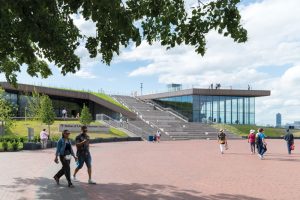
Meeting Aesthetic Requirements
Selecting the precast concrete finish was essential. Designers wanted to make the museum walls darker while keeping in the color family of the Fort Wood sea wall at the statue’s base. “To achieve the right finish, we looked at all the variables related to the mix design: aggregates, pigments, sand, and cement,” Piselli says. The mix design for the structural wythe was a 28-day, 7,000-psi mix. The mix design for the face mix was a 28-day, 5,000-psi mix. Both mixes used a corrosion inhibitor. The architect worked extensively with High Concrete Group, which manufactured the precast concrete, to test different formulations to achieve the right color and texture.
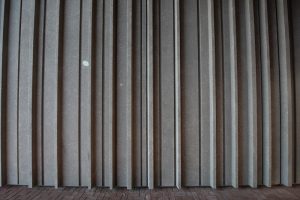
A 4-inch-deep formliner imparted texture and shadow to the 21-inch-thick panels and added the darker tones the design team wanted to complement the context and site. In addition, the vertical ribbed pattern echoed the striated look of the nearby Palisades cliffs. “The overall effect is that the precast concrete looks like stone lifted out of the ground, which makes it feel like part of the landscape,” says Piselli.
The project team and the Statue of Liberty-Ellis Island Foundation committee, which raised money to construct the new museum, provided opinions on the numerous samples and mock-ups that were cast. The mock-up panel was ferried around the island to view it in various sun and shade angles to provide differing perspectives.
Working Between Tourists
High Concrete Group manufactured the precast concrete at its plant in Pennsylvania. The pieces were shipped individually on a trailer and transported on a barge to the island. As the trailers drove onto the island, a crew of ironworkers used a crane to pick the pieces off the trailer and place them on the foundation. While assembled on-site, each piece was already a fully insulated architectural panel that needed minimal work after being placed.
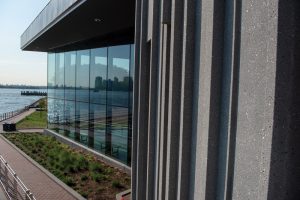
Precast concrete was transported by truck to Jersey City, NJ, where a barge ferried four truck trailers at a time with panels, some weighing 50,000 pounds, to the site. The only cargo service to Liberty Island was from Staten Island, two miles away. Since construction could not disrupt tourism, Phelps Construction built a temporary dock to receive construction materials and personnel. With no staging area on Liberty Island, an average of eight panels were installed per day. The fully insulated architectural panels provided enclosure for the primary building as they were erected, which helped speed construction.
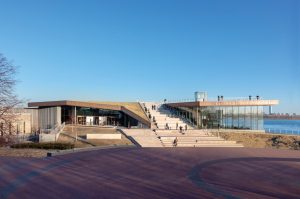
Precast concrete can be an excellent solution for the durable, resilient, high-performance building enclosures found on this project, says High Concrete Group President J. Seroky. Precast concrete was the only material possible, considering the logistics and speed required. The new 26,000-square-foot museum opened in May 2019.■
Project Team
Owners: Statue of Liberty and Ellis Island Foundation working in partnership with the National Park Service/U.S. Department of the Interior
Engineer: DeSimone Consulting Engineers, New York, NY
Designer: FXCollaborative, New York, NY
Contractor: Phelps Construction Group, Boonton, NJ
PCI-Certified Precast Concrete Producer: High Concrete Group, LLC, Denver, PA
PCI-Certified Erector: Precast Services Inc., Morgantown, PA
